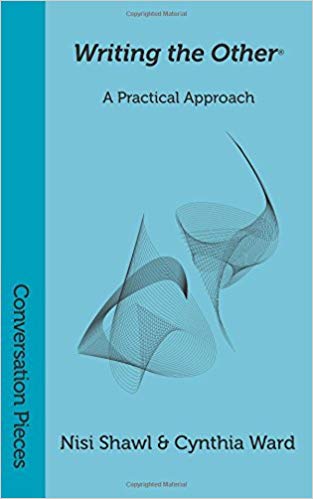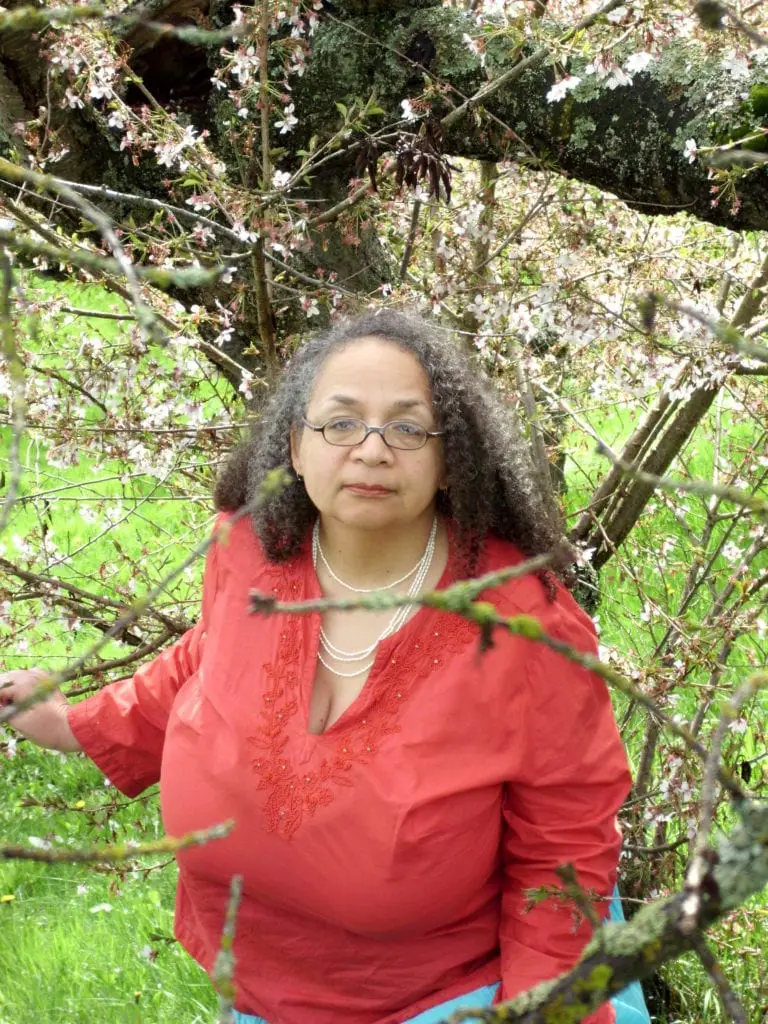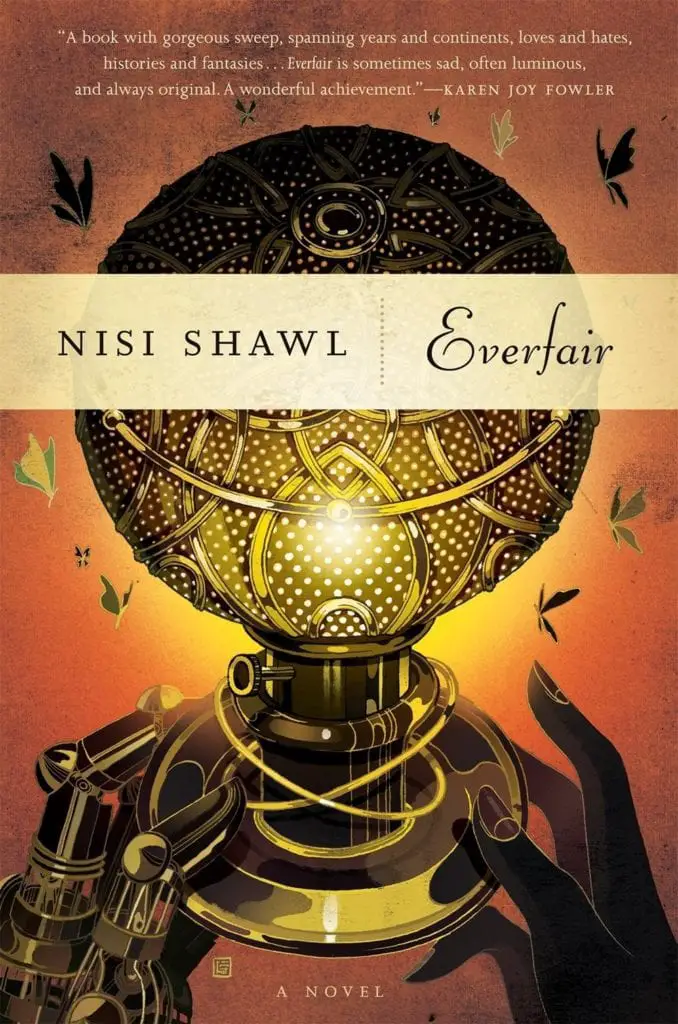Have I mentioned lately that I love books? Probably, but I’ll say it again. As much as I enjoy visual media, books will always have my heart before all else. So, when I got the chance to meet science fiction/fantasy writer Nisi Shawl at WisCon, one of my personal writing icons, I jumped at it. And then I asked to interview her about her writing, her novel Everfair (if you haven’t read it yet, GO DO IT), and her work with “Writing the Other.” Even if you haven’t read any of my other Creator Corner series of interviews, you have to read this one. And then go buy Everfair. (It’s SO GOOD, you guys.)
Gretchen: You’ve been published for almost thirty years now, so tell me, what inspired you to start writing science fiction and fantasy stories? Were they genres you grew up reading?
Nisi Shawl: I absolutely grew up reading SF and fantasy. Of course fairy stories are standard for children, and I blew through as many of those as I could—I remember hunting down Andrew Lang’s collections, for instance. Mary Norton’s Borrowers series was a distinct comfort, and Tatsinda, by Elizabeth Enright, influenced me deeply. (It’s a sort of Lost Race narrative taking place at the North Pole.) There was also a great series of books about Spacecat—an astronaut brings his pet to the moon, and to Mars, and so on. I recently bought a Spacecat t-shirt, which I wear with great pride. And of course I adored Eleanor Cameron’s series about a backyard inventor, a hidden twin Earth, and adventurous boys, which begins with The Wonderful Flight to the Mushroom Planet.
In 6th grade I convinced the librarians downtown to let me read from the adult stacks, so I graduated then from the juveniles to SF and F by Clifford Simak, Poul Anderson, Ray Bradbury, and many other geniuses. Pretty much all of them were white cis het males in the early 1960s, the time I’m talking about. I didn’t let that stop me from living on them.
So when I began to write my own stories, they were speculative fiction, too. Of course. Starting with the postapocalyptic teen romance story I penned at 15. I have no idea where that ms. is, by the way, but I’m not worried by the loss. It was probably just awful. In college I wrote and actually submitted a fantasy about fornicating centaurs. That one, too, is blessedly missing.
 G: You are probably best known for Writing the Other, which you co-authored with Cynthia Ward, and the workshops you and your team offer for writing diverse, inclusive fiction. How did that come about?
G: You are probably best known for Writing the Other, which you co-authored with Cynthia Ward, and the workshops you and your team offer for writing diverse, inclusive fiction. How did that come about?
NS: There’s an account up at the publisher’s website that I’ll refer you to as far as the genesis of the original book and class. Later classes and essays are refinements on that work, and extensions of it, and they are based on student and reader feedback.
G: Have you faced any challenges or pushback in the process of creating the Writing the Other workshops? What have been the greatest rewards thus far?
NS: No one has doxxed me yet or issued death threats. There is a general, overall dislike and distrust in some literary circles of the use of sensitivity readers and the idea of paying attention to representation. A few proponents of the #OwnVoices philosophy have somehow concluded that we who advocate Writing the Other are a.) targeting the use of its techniques solely for white people and/or b.) opposed to the #OwnVoices movement. No one who has taken a Writing the Other class is under either of those erroneous impressions.
They say the sincerest form of flattery is imitation, and I’ve occasionally been flattered in that form. At one point, Cindy Ward (my Writing the Other co-author) copyrighted the phrase “Writing the Other” to help stem the flattering flood. But that’s somewhat counterproductive, as we’ve come to see—we *want* people to talk about this subject on panels and write articles about it and so on. Only, as I’ve told one person who was editorializing on Writing the Other, it would be nice to get credit for my two decades of work in this arena.
The most rewarding results by far are the many books and stories created by our students with the tools and techniques the class gives them.
G: Have your experiences as a black woman shaped the stories that you want to tell and your pedagogy in teaching others how best to represent marginalized communities in their own writing?
NS: Yes indeed! At least, I think so—I haven’t always been a woman (I was a girl for a few years), but I’ve always been black, so no idea what my stories and pedagogy would be like otherwise. But I draw directly on my experiences in both my writing and my teaching. “Wallamelon” (originally printed in Asimov’s SF Magazine and subsequently collected in Filter House) is set in my old neighborhood. One Writing the Other lecture cites an encounter I had while apartment hunting, and others are similarly grounded.
We writers tell ourselves “It’s all material” when undergoing a hardship or “interesting” experience. It’s all going to inform what we create. Getting my hair chemically straightened, getting beat up for “talking white,” getting cast as a black cat rather than the female lead in a youth theater production—it’s all material.
G: You also write your own fiction, primarily short stories. Are there any consistent themes or story elements that run through all of your work?
Themes are things readers find, not things authors insert. I’ve been told my work focuses on ecology, that it’s closely concerned with gender and race, and that it’s decidedly pacifist in its take on the world. Several people I respect say the element of voice is important in my fiction—that my characters’ multiplicity of dictions and rhythms and referents defines it.
What I care about is community. That is probably evident in my work as well.
G: Who have been your greatest inspirations, whether as a writer or as a teacher?
As I writer I will always point to four people who have helped me immensely. Two nongenre authors whose craft in the area of description I turn to again and again are Raymond Chandler and Colette. Both write so vividly of inanimate objects and settings that these take on all the life and unforgettableness of active characters. Two genre authors I rely on are Samuel R. Delany and Connie Willis. Delany does everything I want to do, and I’m constantly analyzing his style, his word choices, his pacing, his honesty, his granularity of vision, his prioritizing—and more. Connie Willis has taught me so much about the value of misdirection in with her writing. Her dialogue is a treat and a study.
Additionally, Eileen Gunn has learned me a few things about humor and audacity. Octavia Butler’s whole life was a lesson in graciousness.
My teaching inspiration will probably surprise you: I’m very conscious of the debt I owe performance artist Laurie Anderson. Really. Teaching is a performance. Most rock stars and actors contribute something to my practice as a teacher.
G: With Black Panther getting high praise for depicting an alternate history to colonized Africa, tell me a bit more about your own alternate history of Belgian Congo, Everfair. What was your inspiration for this story?
NS: I was inspired by my dislike of steampunk. I tell the whole story over on John Scalzi’s blog, “Whatever” (my contribution is available here). Basically, I had to appear on a World Fantasy convention steampunk panel, which led me to question my revulsion for the genre. During the panel I challenged myself to write a steampunk novel set in the midst of one of the world’s worst humanitarian crises. Then I figured out how to do it.
As I wrote, I researched, and as I researched, I found more and more inspiration. The history of the Chinese railway workers Leopold imported gave rise to Tink and Bee-Lung, who’ll also now be viewpoint characters in Everfair’s sequel, Kinning. A photo of an outrageous Congolese hat led to the scene in which his headgear helps Matty fend off an assassination attempt. And so on.
G: The novel features several queer women as main characters, and they’re far from perfect or even entirely positive. Why, to you, is it important that characters of marginalized identities are allowed to be flawed?
NS: So if inclusiveness is going to reflect the world we live in, it needs to do that authentically. It needs to represent human stupidity, stubbornness, greed, and all our other regrettable qualities. Fully human beings have these qualities to greater and lesser degrees, and depicting marginalized characters as lacking them reduces such depictions to caricatures. We must insist on rounded and complete characters when including those identified with the margins, just as we insist on roundedness and completeness in characters identified with the dominant center.
G: I’ve been loving all the Afrofuturist stories I see coming out these days—Black Panther, Nnedi Okorafor’s Binti series and Who Fears Death, Janelle Monáe, N. K. Jemisin, and Octavia Butler spring to mind. What do you see is the primary importance of Afrofuturism in science fiction?
NS: The importance of Afrofuturism is two-fold. First, it shows African and Afrodiasporic readers and writers that representation within the genre is possible and powerful, that it not only exists but that it is a force to be reckoned with. Second, it shows everyone else the same thing. I am 100% certain that I owe the willingness of Tor to contract for an Everfair sequel to Black Panther’s success.
G: What’s coming up next for you? Any other projects you’re working on that you can tell us or hint to us about?
NS: So much! I just turned in revisions on a short story I’m hoping will appear in the special Disabled People Destroy SF issue of Uncanny Magazine. The story is called “The Things I Miss the Most,” and it’s about an epilepsy patient whose successful therapy has unintended consequences.
Next, I’m focusing on revisions to my Middle Grade novel Speculation, which Lee & Low are publishing next year. My great editor, Cheryl Klein, describes it as Toni Morrison’s Beloved as by Edward Eager, and I’m cool with that description. Simultaneously, I’ll be sending out edits to contributors to an anthology I’m editing for Solaris Books. That’s called New Suns: Original Speculative Fiction by People of Color, and it is fantastic! Seventeen stories, and an introduction by LeVar Burton. I posted the TOC some time ago, and it includes big names like Steven Barnes and Hiromi Goto, and newcomers like Alex Jennings and Darcie Little Badger.
But wait! There’s more! I’m about 65% done with a novella I’m writing for Rosarium, a sort of retelling of Jack Kerouac’s three-month affair with a black woman known in his books as Mardou Fox. And if there’s going to be a sequel to Everfair called Kinning, I better write it. I mean, I have an outline, but there’s gotta be more than that if I want my readers satisfied. My current plan is to swap viewpoints between two sets. First there’s Tink and his sister Bee-Lung sailing an aircanoe around the world, spreading the spores of anarchism. Then there’s Princess Mwadi and her brother Prince Ilunga, struggling over the succession for the rulership of Everfair.
If I have time, there are a couple of short stories I have promised to write too.
G: Anything else you want to share with us before we go?
NS: A cup of tea? I make my own blends…Okay, seriously, there are a couple of fundraisers going on currently which I’m involved with. One is in honor of Octavia E. Butler’s 71st birthday, to solicit donations for the Carl Brandon Society (CBS). Octavia was a CBS member, and we administer a scholarship in her name, and present a literary award linked to her legacy. More details are available on the CBS website. That fundraiser runs June 22 – July 22, 2018. The other is Clarion West’s annual Write-a-thon. I attended CW in 1992, and I’m participating in the Wat, which you can learn about here.
And with that, I bid you all a fond adieu. Stay strong. Stay loving. Stay true.
—
Author Bio

Nisi Shawl wrote the AfroRetroFuturist novel Everfair, a Nebula Award finalist set in an imaginary Utopia in the Congo; and the James Tiptree, Jr. Award-winning story collection Filter House. Tor.com invited her to expand her “Crash Course in the History of Black Science Fiction” essay into a monthly column, and she is obliging. She co-edited the anthologies Stories for Chip: A Tribute to Samuel R. Delany; and Strange Matings: Science Fiction, Feminism, African American Voices, and Octavia E. Butler. Shawl lives in Seattle, taking walks with her mother June and her cat Minnie at the pace of an entitled feline.
—
You can find Nisi Shawl on her website and Patreon. To find out more about her work with Writing the Other, visit: http://writingtheother.com/. Make sure you also check out her Tor.com column and Seattle review of Books column!


